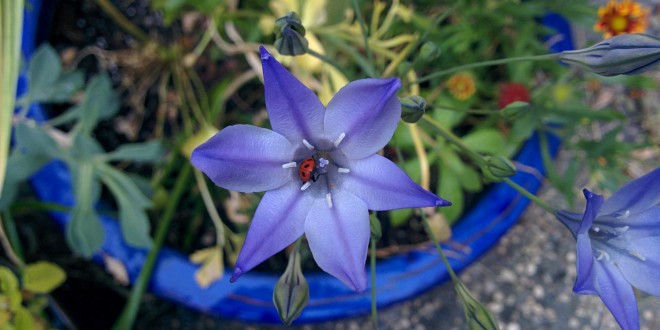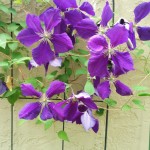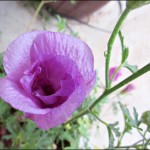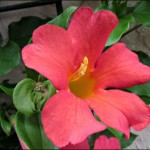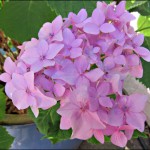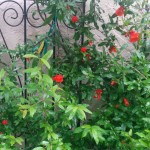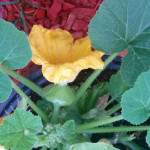There was lots of activity in our Sunnyvale garden this past May: Spring flowers were finishing their bloom;. Summer flowers were pumping out new growth and, in some cases, early flowers. The stone fruits- plums, nectarines, and apricots – got larger and starting getting color. The tomato plants range in size from 2 to 4 feet in height. Some are flowering and some even have green fruit.
In May, I repaired the drig irrigation system. Over the course of the winter and spring, the emitter heads get stepped on or accidently cut. From a single faucet, I have 150 feet of 1/2 inch main line with about 100 smaller feeder tubes. For trees, I might have 2 emitters that drip 1/2 gallon per hour. For tomatos and larger pots there might be 2 emitters that drip 1/4 gallon per hour.
Spring Flowers - Amaryllis
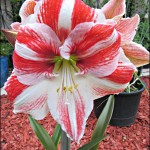 A couple of years ago I bought a Christmas Amaryllis for Marie. After the season, I planted the bulb outdoors. Every year since, it produces a stalk with several giant flowers. Amaryllis are bulbs of the genus Hippeastrum that are native to tropical and subtropical areas of the Americas. Some species grow in rock crevices in savannas that have distinct dry and wet seasons; others grow in high plateau regions that have cool weather for most of the year. One species from Brazil is epiphytic and grows in trees in montane forests with no soil around the roots. Most of these hybrid species experience warm, humid conditions with abundant rainfall for most of the year and a short, cooler dry season. To make your amaryllis bloom again, you simply have to mimic the conditions that nature provides.
A couple of years ago I bought a Christmas Amaryllis for Marie. After the season, I planted the bulb outdoors. Every year since, it produces a stalk with several giant flowers. Amaryllis are bulbs of the genus Hippeastrum that are native to tropical and subtropical areas of the Americas. Some species grow in rock crevices in savannas that have distinct dry and wet seasons; others grow in high plateau regions that have cool weather for most of the year. One species from Brazil is epiphytic and grows in trees in montane forests with no soil around the roots. Most of these hybrid species experience warm, humid conditions with abundant rainfall for most of the year and a short, cooler dry season. To make your amaryllis bloom again, you simply have to mimic the conditions that nature provides.Spring Flowers - Watsonia
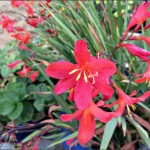 Watsonia are both evergreen and perennial. Our Watsonia grows every year. If you want the plant in another location, just move the corm. Corms have these traits: Corms have a tunic; Corms have a basal plate at the bottom and one or more growing points at the top; Corms are undifferentiated, uniform, and contain no rings when cut apart.
Watsonia are both evergreen and perennial. Our Watsonia grows every year. If you want the plant in another location, just move the corm. Corms have these traits: Corms have a tunic; Corms have a basal plate at the bottom and one or more growing points at the top; Corms are undifferentiated, uniform, and contain no rings when cut apart.
Many are quite tall with fans of sword-shaped leaves and spikes of showy (often many) flowers that are usually pink, bright red or orange. They are popular garden plants in countries where they are hardy with many attractive cultivars available. Their bright colors and tall flowering spikes can make them a very prominent part of the garden when in bloom.
Spring Flowers - Tropical Milkweed
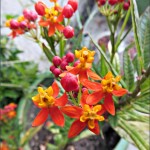 Tropical Milkweed, while not technically native to the United States, is widely popular in butterfly gardens. Growing as a naturalized perennial plant in the southern U.S., it can also be easily started from seeds in the northern U.S. and treated as an annual. For an even longer blooming period in colder regions, Tropical Milkweed plants are easily potted up in the fall and grown indoors over the winter.
Tropical Milkweed, while not technically native to the United States, is widely popular in butterfly gardens. Growing as a naturalized perennial plant in the southern U.S., it can also be easily started from seeds in the northern U.S. and treated as an annual. For an even longer blooming period in colder regions, Tropical Milkweed plants are easily potted up in the fall and grown indoors over the winter.Spring Flowers - Calendula
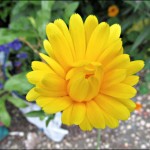 Edible, ornamental and strikingly colorful, calendula (Calendula officinalis) works in the herb garden, vegetable garden and flower garden. Calendula, also commonly called pot marigold, is a cool-season annual flower that grows well in fall, winter and early spring in mild coastal areas and Mediterranean gardens. Add calendula to border areas and cottage gardens for its striking color. In the herb and vegetable garden, calendula attracts beneficial insects and you can harvest the petals to sprinkle on desserts and salads.
Edible, ornamental and strikingly colorful, calendula (Calendula officinalis) works in the herb garden, vegetable garden and flower garden. Calendula, also commonly called pot marigold, is a cool-season annual flower that grows well in fall, winter and early spring in mild coastal areas and Mediterranean gardens. Add calendula to border areas and cottage gardens for its striking color. In the herb and vegetable garden, calendula attracts beneficial insects and you can harvest the petals to sprinkle on desserts and salads.Spring Flowers - Alstroemeria
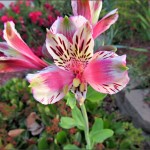 Alstroemerias are best known as cut flowers, where their rich colors and lovely veining grace many a vase, where they’ll last for as long as two weeks. But they can also be grown in the garden, where they do best in light, well-drained soil. They bloom freely through the summer and come in almost all shades of the rainbow except true blue. Alstroemeria are drought tolerant. They spread by rhizomes – Ours has spread 6 feet from its original location.
Alstroemerias are best known as cut flowers, where their rich colors and lovely veining grace many a vase, where they’ll last for as long as two weeks. But they can also be grown in the garden, where they do best in light, well-drained soil. They bloom freely through the summer and come in almost all shades of the rainbow except true blue. Alstroemeria are drought tolerant. They spread by rhizomes – Ours has spread 6 feet from its original location.Spring Flowers - Clematis vine
Spring Flowers - Bearded Iris
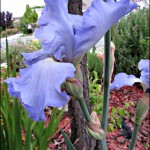 It’s a magical time when bearded irises unfurl their pencil-slim buds to reveal a kaleidoscope of color in spring. Once commonly called flags, these perennials flourish in USDA Zones 3-9, where winter temperatures dip below freezing and allow the plant to go dormant before next year’s growth.
It’s a magical time when bearded irises unfurl their pencil-slim buds to reveal a kaleidoscope of color in spring. Once commonly called flags, these perennials flourish in USDA Zones 3-9, where winter temperatures dip below freezing and allow the plant to go dormant before next year’s growth.
Ours bloomed in May this year.
Spring Flowers - Queen Fabiola
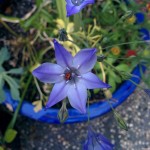 “Queen Fabiola” brodiaea (Brodiaea laxa “Queen Fabiola”) is commonly known as the triplet lily or wild hyacinth. This perennial bulb is a native wildflower to California, growing wild in evergreen woodlands. Grass-like leaves appear first, followed by clusters of light blue blossoms reaching 15 to 20 inches tall and appearing in the late spring. Triplet lilies grow best in U.S. Department of Agriculture plant hardiness zones 7 through 10. Fall is the best time to plant these bulbs in flower beds and rock gardens.
“Queen Fabiola” brodiaea (Brodiaea laxa “Queen Fabiola”) is commonly known as the triplet lily or wild hyacinth. This perennial bulb is a native wildflower to California, growing wild in evergreen woodlands. Grass-like leaves appear first, followed by clusters of light blue blossoms reaching 15 to 20 inches tall and appearing in the late spring. Triplet lilies grow best in U.S. Department of Agriculture plant hardiness zones 7 through 10. Fall is the best time to plant these bulbs in flower beds and rock gardens.Spring Flowers - Nigella
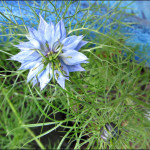 Love-in-a-mist (Nigella damascena) is a charming old-fashioned annual in the buttercup family (Ranunculaceae) that blooms in spring and early summer. Ours bloomed in May. One of about 15 species in the genus Nigella, love-in-a-mist is native to southern Europe and northern Africa. In its native habitat, this plant grows in fields, along roadsides, and in rocky or waste ground.
Love-in-a-mist (Nigella damascena) is a charming old-fashioned annual in the buttercup family (Ranunculaceae) that blooms in spring and early summer. Ours bloomed in May. One of about 15 species in the genus Nigella, love-in-a-mist is native to southern Europe and northern Africa. In its native habitat, this plant grows in fields, along roadsides, and in rocky or waste ground.Summer Flowers - Double Hibiscus
Summer Flowers - Monkey Flower
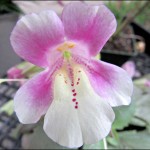 Mimulus naiandinus – Abundant REALLY LARGE fanciful blooms appear Spring thru Summer on this new “Monkey Flower” variety. Twice the size of the original species (2” top to bottom), ‘Mega’s’ romantic creamy white flowers are blushed cherry & garnished with a yellow throat & showy spots. Dark branching stems, refined blue-green foliage & a bushy 20” high & wide form completes the “must have” picture. EASY & fast. Cut back anytime to refresh growth and bloom. Deciduous but reliably returns each Spring. Rich soil. Self-sows!
Mimulus naiandinus – Abundant REALLY LARGE fanciful blooms appear Spring thru Summer on this new “Monkey Flower” variety. Twice the size of the original species (2” top to bottom), ‘Mega’s’ romantic creamy white flowers are blushed cherry & garnished with a yellow throat & showy spots. Dark branching stems, refined blue-green foliage & a bushy 20” high & wide form completes the “must have” picture. EASY & fast. Cut back anytime to refresh growth and bloom. Deciduous but reliably returns each Spring. Rich soil. Self-sows!Summer Flowers - Meadow Foam
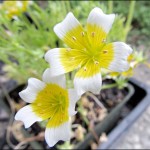 Highly rewarding & a cinch to grow, “Meadow Foam” is also great smelling – like Narcissus! A California native, Meadow Foam is not fussy about soil, it spreads into a low, shiny, weed– suppressing mat to 30” across. Very long blooming with a mass of charming, 1” clear white and lemony yellow 2-toned blooms on 10” stems. Superb as edging and swell in pots (at least 10” across). Reseeds! Very Showy!
Highly rewarding & a cinch to grow, “Meadow Foam” is also great smelling – like Narcissus! A California native, Meadow Foam is not fussy about soil, it spreads into a low, shiny, weed– suppressing mat to 30” across. Very long blooming with a mass of charming, 1” clear white and lemony yellow 2-toned blooms on 10” stems. Superb as edging and swell in pots (at least 10” across). Reseeds! Very Showy!Summer Flowers - Rhodohypoxis
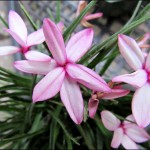 Rhodohypoxis baurii Pintado is a small, showy perennial prized for rock garden and pot culture with thickened, cormlike rhizomes from which clumps of hairy, grasslike leaves appear in spring. Beginning a few weeks later and often continuing well into the summer, many small 6-parted blossoms are displayed on individual 3-4 inch stems. ‘Pintado’ has pale pink blossoms shading to deep red at the tips of the petals. It is also the most fragrant of all the cultivars we have grown. Winter deciduous. Sun, well drained soil, moderate watering. Shield them from winter rains if possible.
Rhodohypoxis baurii Pintado is a small, showy perennial prized for rock garden and pot culture with thickened, cormlike rhizomes from which clumps of hairy, grasslike leaves appear in spring. Beginning a few weeks later and often continuing well into the summer, many small 6-parted blossoms are displayed on individual 3-4 inch stems. ‘Pintado’ has pale pink blossoms shading to deep red at the tips of the petals. It is also the most fragrant of all the cultivars we have grown. Winter deciduous. Sun, well drained soil, moderate watering. Shield them from winter rains if possible.Summer Flowers - Red Trumpet Vine
Summer Flowers - Mums
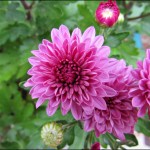 I swear I planted the same type of mums in two large pots. In one pot, all the mums are 2 feet tall. In the other pot, all the mums are 4 feet tall. The right chrysanthemum flowers for your garden will come from a diverse selection of hardy or garden mums. When growing mums, you’ll find plants that are dwarf to giant, in colors from white and yellow to the deepest burgundy and purple. Some cultivars bloom in summer, while others bloom as late as October.
I swear I planted the same type of mums in two large pots. In one pot, all the mums are 2 feet tall. In the other pot, all the mums are 4 feet tall. The right chrysanthemum flowers for your garden will come from a diverse selection of hardy or garden mums. When growing mums, you’ll find plants that are dwarf to giant, in colors from white and yellow to the deepest burgundy and purple. Some cultivars bloom in summer, while others bloom as late as October.Summer Flowers - Hydrangea
Summer Flowers Calibrochoa
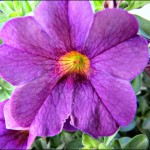 Like a tiny petunia on steroids, calibrachoa (also called million bells) grows and flowers at an amazing rate. Often confused for a petunia, million bells makes a splash no matter where you put it in the garden. It is perfect for containers or hanging baskets but also can be tucked into the front of a border where it will spill out onto sidewalk or patio. In fact, it may be the ultimate “spiller” for container gardens as long as you give it ample water and fertilizer, which it needs to fuel its astounding growth.
Like a tiny petunia on steroids, calibrachoa (also called million bells) grows and flowers at an amazing rate. Often confused for a petunia, million bells makes a splash no matter where you put it in the garden. It is perfect for containers or hanging baskets but also can be tucked into the front of a border where it will spill out onto sidewalk or patio. In fact, it may be the ultimate “spiller” for container gardens as long as you give it ample water and fertilizer, which it needs to fuel its astounding growth.Feijoa
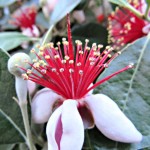 Our 15 year-old feijoa tree always produces these spectacular ref flowers in May. The spongy petals are edible – they have a cinnamon flavor. The jay birds love them. Acca sellowiana, a species of flowering plant in the myrtle family, is native to the highlands of southern Brazil, eastern Paraguay, Uruguay, northern Argentina, and Colombia. It is widely cultivated as a garden plant and fruiting tree. Common names include feijoa, pineapple guava and guavasteen, although it is not a true guava. It is an evergreen, perennial shrub or small tree, 3.3–23.0 ft in height, widely cultivated as an ornamental tree and for its fruit.
Our 15 year-old feijoa tree always produces these spectacular ref flowers in May. The spongy petals are edible – they have a cinnamon flavor. The jay birds love them. Acca sellowiana, a species of flowering plant in the myrtle family, is native to the highlands of southern Brazil, eastern Paraguay, Uruguay, northern Argentina, and Colombia. It is widely cultivated as a garden plant and fruiting tree. Common names include feijoa, pineapple guava and guavasteen, although it is not a true guava. It is an evergreen, perennial shrub or small tree, 3.3–23.0 ft in height, widely cultivated as an ornamental tree and for its fruit.Pomegranate
Blackberry Tart
 We have two types of blackberries: The classic and the Marionberry. The classic has thinner canes and a sweeter berry. The Marionberry has a thicker cane that can grow 20 feet long in a season. The dark blue colour ensures blackberries have one of the highest antioxidant levels of all fruits. Antioxidants, well-known for lowering the risk of a number of cancers, are a huge bonus, but be aware the berries are best consumed in their natural state to get the full benefits.
We have two types of blackberries: The classic and the Marionberry. The classic has thinner canes and a sweeter berry. The Marionberry has a thicker cane that can grow 20 feet long in a season. The dark blue colour ensures blackberries have one of the highest antioxidant levels of all fruits. Antioxidants, well-known for lowering the risk of a number of cancers, are a huge bonus, but be aware the berries are best consumed in their natural state to get the full benefits.Spring Vegetables - Kale
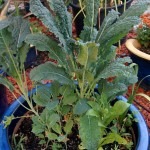 You can pick spring-planted kale all summer, but leaves may get tough and bitter when heat arrives. Quality improves again in fall and plants continue growing even winter in mild climates. Frost makes them taste sweeter, and plants are cold-hardy at least to the low 20s. The following spring, though, they will bolt.
You can pick spring-planted kale all summer, but leaves may get tough and bitter when heat arrives. Quality improves again in fall and plants continue growing even winter in mild climates. Frost makes them taste sweeter, and plants are cold-hardy at least to the low 20s. The following spring, though, they will bolt.Summer Fruit - Pepino Melon
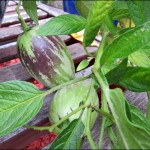 I bought a Pepino melon about 3 years ago at the Santa Clara Valley Masters Gardeners Spring Sale. Pepino melons are not really melons; they are the fruit of a South American evergreen and actually related to the tomato and the eggplant. I transplanted it to a larger pot this past year and it is producing a lot of fruit
I bought a Pepino melon about 3 years ago at the Santa Clara Valley Masters Gardeners Spring Sale. Pepino melons are not really melons; they are the fruit of a South American evergreen and actually related to the tomato and the eggplant. I transplanted it to a larger pot this past year and it is producing a lot of fruitSummer Vegetables - Tivoli Squash
Summer Vegetables - Patty Pan Squash
Summer Vegetables - Rhubarb
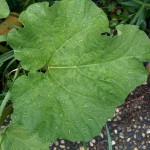 Our Rhubard plant has been struggling the last few weeks of the heat wave. I need to transplant to a larger pot where it is less subject to drying out. Rhubarb is often dubbed the “pie plant,” and the stalks, soft and delectable when baked, do make a divine pie filling. But pie is by no means the only way to experience rhubarb. It’s delicious in all kinds of desserts, and this tart vegetable also works well in savory dishes.
Our Rhubard plant has been struggling the last few weeks of the heat wave. I need to transplant to a larger pot where it is less subject to drying out. Rhubarb is often dubbed the “pie plant,” and the stalks, soft and delectable when baked, do make a divine pie filling. But pie is by no means the only way to experience rhubarb. It’s delicious in all kinds of desserts, and this tart vegetable also works well in savory dishes.Wall of Tomatoes
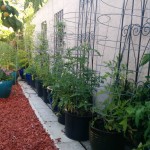 All of our tomato plants have been transplanted to their final pots. We have 24 plants of 20 varieties. Most pots have 2 plants. I store the tomato cages on the flat root during the off season. The plants are from 2 to 4 feet tall. About half of them starting flowering in the past two weeks. Several of them have green fruit on them already.
All of our tomato plants have been transplanted to their final pots. We have 24 plants of 20 varieties. Most pots have 2 plants. I store the tomato cages on the flat root during the off season. The plants are from 2 to 4 feet tall. About half of them starting flowering in the past two weeks. Several of them have green fruit on them already.